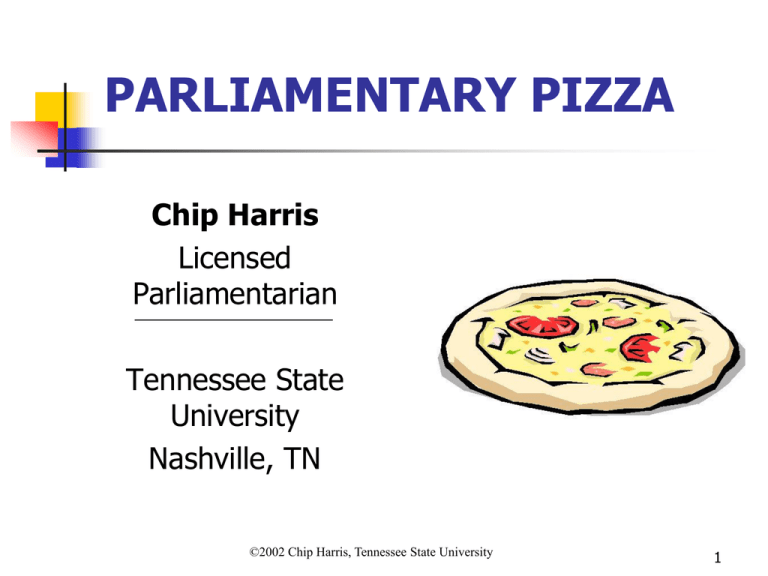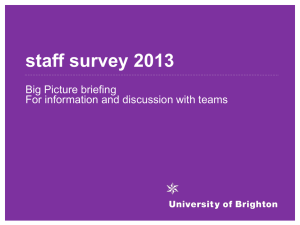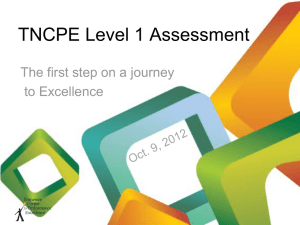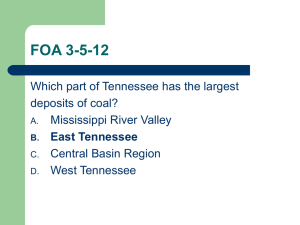PARLIAMENTARY PIZZA
advertisement

PARLIAMENTARY PIZZA Chip Harris Licensed Parliamentarian Tennessee State University Nashville, TN ©2002 Chip Harris, Tennessee State University 1 What is a meeting? A time when people come together to make decisions Let’s give some examples…. ©2002 Chip Harris, Tennessee State University 2 What is a meeting? How many meetings do you attend each day? Informal meetings take place all the time. A formal meeting is what we will discuss today. ©2002 Chip Harris, Tennessee State University 3 Parliamentary Procedure A set of rules that governs meetings. Three basic rules One thing at a time Majority Rules Minority Rights Guaranteed Always follow Common courtesy ©2002 Chip Harris, Tennessee State University 4 Meeting Agenda Call to Order Reading and approval of Minutes Reports of Officers, Boards, Standing Committees Reports of Special Committees Unfinished Business New Business Adjournment ©2002 Chip Harris, Tennessee State University 5 How to make a Decision? Argue? Fight? Stalemate? Main Motion! ©2002 Chip Harris, Tennessee State University 6 First, be recognized You have to get “the floor” which is the right to speak. Stand and say, Mr./Madame Chair OR Raise your hand OR Just stand and raise your hand. ©2002 Chip Harris, Tennessee State University 7 First, be recognized The Chair/President will “give you the floor” by saying, “the Chair recognizes…… Now you have the right to speak ©2002 Chip Harris, Tennessee State University 8 Main Motion 1. Introduced 2. Seconded 3. Presented to Assembly by the Chair 4. Discussion/Debate 5. Put to vote 6. Announcement ©2002 Chip Harris, Tennessee State University 9 Main Motion 1. Introduce • I move that… • State your idea specifically and simply 2. Second • Someone who agrees the ideas should be discussed • Does not have to favor the idea • Does not need to be recognized • Second! ©2002 Chip Harris, Tennessee State University 10 Main Motion 1. Introduced 2. Seconded 3. Presented to Assembly by Chair • • It has been moved and seconded that… Are you ready for the question? ©2002 Chip Harris, Tennessee State University 11 Main Motion 1. Introduced 2. Seconded 3. Presented 4. Discussion Rules and Hints ©2002 Chip Harris, Tennessee State University 12 Debate Rules One speaker at a time May speak twice on an issue May not speak a second time until everyone has had the chance to speak the first time Speak to the Chair Speak about the issue, not the person Maker of motion has first right to speak ©2002 Chip Harris, Tennessee State University 13 Debate Hints Express position Give reasons why Purpose to convince the undecided Ask for support ©2002 Chip Harris, Tennessee State University 14 Main Motion 1. Introduce 2. Second 3. Present 4. Discussion/Debate 5. Put to vote ©2002 Chip Harris, Tennessee State University 15 Main Motion 5. Put to vote • If there is no further discussion, we will vote on the motion that…. (repeat motion) • As many as are in favor, say aye…. • • As many as are opposed, say no… • • Allow time for response Allow time for response Alternate methods of voting ©2002 Chip Harris, Tennessee State University 16 Main Motion 6. Announcement The ayes are in the majority and the motion carries The noes have it and the motion is lost ©2002 Chip Harris, Tennessee State University 17 Example Main Motion Be recognized by the Chair • Mr/Madame Chair, I move that we have pizza for lunch. • I second the motion. OR Second! • It has been moved and seconded that we have pizza for lunch. Are you ready for the question? ©2002 Chip Harris, Tennessee State University 18 Example Main Motion 4. Debate I speak in favor of the motion because…. I speak in opposition to the motion because… Alternate positions if known Listen to debate, it might change your mind ©2002 Chip Harris, Tennessee State University 19 Main Motion 5. Put to vote If there is no further discussion, we will proceed to vote on the motion that we have pizza for lunch. As many as are in favor, say aye. Allow time to vote and determine result As many as are opposed, say no Allow time to vote and determine result ©2002 Chip Harris, Tennessee State University 20 Voting The Chair determines the method of voting and announces it as part of step 5. Most votes are voice votes (aye, no) or show of hands. A 2/3 vote requires voting by standing. ©2002 Chip Harris, Tennessee State University 21 Main Motion 6. Announcement The ayes are in the majority and the motion to/that….is adopted/carried. We will… The noes are in the majority and the motion to/that….is lost. Now you can move on to something else. ©2002 Chip Harris, Tennessee State University 22 ©2002 Chip Harris, Tennessee State University 23 Main Motion 1. Introduced 2. Seconded 3. Presented to Assembly by the Chair 4. Discussion/Debate 5. Put to vote 6. Announcement ©2002 Chip Harris, Tennessee State University 24 Main Motion 1. Introduced 2. Seconded 3. Presented to Assembly by the Chair 4. Discussion/Debate 5. Put to vote 6. Announcement ©2002 Chip Harris, Tennessee State University 25 Example Main Motion Be recognized by the Chair • Mr/Madame Chair, I move that we have pizza for lunch. • I second the motion. OR Second! • It has been moved and seconded that we have pizza for lunch. Are you ready for the question? ©2002 Chip Harris, Tennessee State University 26 Example Main Motion 4. Debate I speak in favor of the motion because…. I speak in opposition to the motion because… Alternate positions if known Listen to debate, it might change your mind. ©2002 Chip Harris, Tennessee State University 27 Main Motion 5. Put to vote If there is no further discussion, we will proceed to vote on the motion that we have pizza for lunch. As many as are in favor, say aye. Allow time to vote and determine result As many as are opposed, say no Allow time to vote and determine result ©2002 Chip Harris, Tennessee State University 28 Main Motion 6. Announcement The ayes are in the majority and the motion to/that….is adopted/carried. We will… The noes are in the majority and the motion to/that….is lost. Now you can move on to something else. ©2002 Chip Harris, Tennessee State University 29 What happens if….. You decide the idea is good, but could be better with some changes? ©2002 Chip Harris, Tennessee State University 30 You can change it…. A change is called an “Amendment” ©2002 Chip Harris, Tennessee State University 31 Amendment Amendments can be made by Addition – adding something Subtraction – deleting something Substitution - replacing something with something else • Use the same 6 steps…. ©2002 Chip Harris, Tennessee State University 32 Amendment Take priority over the main motion Must deal with amendment first Occur during the debate of a motion Follow same 6 steps as a main motion Requires a majority vote ©2002 Chip Harris, Tennessee State University 33 Amendment If your amendment is adopted, you have changed the original motion and the debate then goes to the new or amended motion. If your amendment is defeated, you return to debate on the original main motion. ©2002 Chip Harris, Tennessee State University 34 Primary Amendment Flow Chart Main Motion 1. Introduce 2. Second 1. 3. Present to Assembly 2. 4. Debate 3. 5. Put to vote 4. Debate 6. Announcement 5. I move to amend the motion by… +, -, S 6. ©2002 Chip Harris, Tennessee State University 35 Amendment Example 1. I move that we have pizza for lunch. 2. Second! 3. It has been moved and seconded that we have pizza for lunch. Are you ready for the question? 4. Debate…. ©2002 Chip Harris, Tennessee State University 36 4. Debate 1. Mr./Madame Chair, I move to amend the motion by adding the word pepperoni before the word pizza. 2. Second. 3. It has been moved and seconded to amend the motion by inserting the word pepperoni before the word pizza. Are you ready for the question? ©2002 Chip Harris, Tennessee State University 37 4. Debate 4. Debate: I speak in favor of the motion because… OR… I speak against the motion because…. 5. Is there any further discussion? Seeing none, we will vote on the amendment to the motion to insert the word pepperoni in front of the word pizza. … ©2002 Chip Harris, Tennessee State University 38 4. Debate (amendment passes) As many as are in favor of the amendment, please say “aye”. (Pause) Those opposed, please say “no”. 6. The “ayes” have it and the amendment is adopted. Therefore, discussion is on the main motion as amended that we have pepperoni pizza for lunch. Are you ready for the question? 5. ©2002 Chip Harris, Tennessee State University 39 4. Debate (amendment fails) As many as are in favor of the amendment, please say “aye”. (Pause) Those opposed, please say “no”. 6. The “noes” have it and the amendment is lost. Therefore, discussion is on the main motion that we have pizza for lunch. Are you ready for the question? 5. ©2002 Chip Harris, Tennessee State University 40 Amendment Example 4. The question before the assembly is that we buy pepperoni pizza for lunch. Are you ready for the question? (Debate amended motion) 5. Seeing no further discussion, we will vote on the motion that we buy pepperoni pizza for lunch. ©2002 Chip Harris, Tennessee State University 41 Amendment Example 5. As many as are in favor of the motion please say “aye”. (Pause) Those opposed, please say “no”. 6. The “ayes” are in the majority and the motion as amended is adopted. We will buy pepperoni pizza for lunch. ©2002 Chip Harris, Tennessee State University 42 ©2002 Chip Harris, Tennessee State University 43 Primary Amendment Flow Chart Main Motion 1. Introduce 2. Second 1. 3. Present to Assembly 2. 4. Debate 3. 5. Put to vote 4. Debate 6. Announcement 5. I move to amend the motion by… +, -, S 6. ©2002 Chip Harris, Tennessee State University 44 Amendments You can amend your amendment if you feel the need. It works just like the main motion and primary amendment. The amendment to the amendment is correctly known as the secondary amendment. ©2002 Chip Harris, Tennessee State University 45 Secondary Amendment Flow Chart 1. Introduce Main Motion 1. 2. 3. 1. Introduce 2. Second 2. Second 3. Present 3. Present to Assembly 4. Debate 4. Debate 6. Announcement 5. Put 5. 4. Debate 6. 5. 6. Announcement ©2002 Chip Harris, Tennessee State University 46 Secondary Amendment Amendment to the Amendment I move that we have pizza for lunch. Second It has been moved….have pizza for lunch. Are you ready for the Question? Debate I move to amend the motion by adding the word “pepperoni” before the word pizza. ©2002 Chip Harris, Tennessee State University 47 Secondary Amendment Second It has been moved and seconded to amend the motion by adding the word “pepperoni” before the word pizza. Are you ready for the question? I move to amend the amendment by adding the words and extra cheese after pepperoni. ©2002 Chip Harris, Tennessee State University 48 Secondary Amendment Second It has been moved and seconded to amend the amendment by adding the words “and extra cheese” after pepperoni. If adopted the amended amendment will read to add the words “pepperoni and extra cheese” before pizza. Are you ready for the question? ©2002 Chip Harris, Tennessee State University 49 Secondary Amendment Debate Seeing no further discussion, we will now vote on the amendment to the amendment to add the words “and extra cheese” after pepperoni. As many as are in favor, say aye. Those opposed say no. ©2002 Chip Harris, Tennessee State University 50 Secondary Amendment The ayes are in the majority and the amendment passes. Discussion is now on the amended amendment that we add the words “pepperoni and extra cheese” before pizza. Are you ready for the question? ©2002 Chip Harris, Tennessee State University 51 Secondary Amendment to Primary Seeing no further discussion, we will vote on the amended amendment to add the words “pepperoni and extra cheese” before the word pizza. As many as are in favor….. The ayes are in the majority and the amendment passes. Discussion is now on the main motion as amended that we have pepperoni and extra cheese pizza for lunch. Are you ready for the question? ©2002 Chip Harris, Tennessee State University 52 Secondary Amendment to Main Seeing no further discussion, we will now vote on the main motion as amended that we have pepperoni and extra cheese pizza for lunch. As many as are in favor….. The ayes are in the majority and the main motion as amended passes. We will have pepperoni and extra cheese pizza for lunch. ©2002 Chip Harris, Tennessee State University 53 Secondary Amendment Flow Chart 1. Introduce Main Motion 1. 2. 3. 1. Introduce 2. Second 2. Second 3. Present 3. Present to Assembly 4. Debate 4. Debate 6. Announcement 5. Put 5. 4. Debate 6. 5. 6. Announcement ©2002 Chip Harris, Tennessee State University 54 Subsidiary Motions Assist in the disposing of a main motion Postpone Indefinitely Amend Refer to committee Postpone to a Certain Time Limit Debate Previous Question Lay on the Table ©2002 Chip Harris, Tennessee State University 55 Subsidiary Motion: Postpone Indefinitely To kill or reject a main motion without running the risk of having a direct vote upon it Must be seconded Is debatable Is not amendable Requires a majority vote I move to postpone the motion indefinitely… ©2002 Chip Harris, Tennessee State University 56 Subsidiary Motion: Amendment To change a pending motion before it is adopted or rejected Must be seconded Is debatable Is amendable Requires a majority vote ©2002 Chip Harris, Tennessee State University 57 Subsidiary Motion: Commit or Refer To send the motion to a committee for further work Must be seconded May be debated May be amended Requires a majority vote I move to refer the pending motion to a committee… ©2002 Chip Harris, Tennessee State University 58 Subsidiary Motion: Postpone to a Certain Time Used to gain information to protect the rights of absent members or to gain time in which to garner support for the proposed motion. Motion must indicate the postponed time, i.e. the next meeting I move to postpone the pending motion until the next regular meeting….. ©2002 Chip Harris, Tennessee State University 59 Subsidiary Motion: Postpone to a Certain Time Must be seconded May be debated (but only to the postpone issue, not the merits of the motion) May be amended Requires a majority vote ©2002 Chip Harris, Tennessee State University 60 Subsidiary Motion: Limit Debate The means an assembly has to exercise special control over debate on a pending question or series of pending questions I move to limit debate to one speech per person…. ©2002 Chip Harris, Tennessee State University 61 Subsidiary Motion: Limit Debate Must be seconded Is not debatable if referring to the pending motion Is amendable Requires a 2/3 vote ©2002 Chip Harris, Tennessee State University 62 Subsidiary Motion: Previous Question Immediately ends debate and the making of subsidiary motions (except Lay on the Table). You vote on the motion immediately upon the ordering of the previous question. I move the previous question. ©2002 Chip Harris, Tennessee State University 63 Subsidiary Motion: Previous Question Must be seconded Is not debatable Is not amendable Requires a 2/3 vote ©2002 Chip Harris, Tennessee State University 64 Subsidiary Motion: Lay on the Table This sets aside a pending motion so as to permit doing something else immediately. Often misused Is not meant to kill a motion. I move to lay the question on the table. Must be seconded, not debatable, is not amendable and requires a majority vote. ©2002 Chip Harris, Tennessee State University 65 Incidental Motions Rise out of another pending motion or item of business Point of Order Appeal Division of the Question Division of the Assembly Parliamentary Inquiry ©2002 Chip Harris, Tennessee State University 66 Incidental: Point of Order Rise to a Point of Order if you feel a rule has been violated, thereby calling on the Chair for a Ruling and enforcement of the rule. I rise to a Point of Order! May interrupt a speaker, does not require a second, is not amendable, debatable or voted upon. ©2002 Chip Harris, Tennessee State University 67 Incidental: Appeal An appeal is used when a member believes the Chair made an incorrect ruling and wants to reverse it. I appeal from the decision of the Chair. May interrupt a speaker, must be seconded, is not debatable or amendable. A majority vote in the negative reverses the Chair’s ruling. ©2002 Chip Harris, Tennessee State University 68 Incidental: Division of the Question When a motion has multiple parts that could each stand alone, the assembly may choose to consider each part individually. Must be seconded, is not debatable, is amendable and requires a majority vote. I move to divide the question into 2 parts consisting of.. or I move to divide the question so as to consider the “part” separately. ©2002 Chip Harris, Tennessee State University 69 Incidental: Division of the Assembly When a member doubts the result of a voice vote or a show of hands vote, he/she can call for a Division of the Assembly. Does not require a second, is not debatable or amendable, does not require a vote. The Chair would immediately take another vote by standing. Division! OR I call for a Division. ©2002 Chip Harris, Tennessee State University 70 Incidental: Parliamentary Inquiry Any member may make a Parliamentary Inquiry relative to a parliamentary issue to organization rule. Does not require a second, is not debated or amended and there is no vote taken. The Chair is responsible to respond to the inquiry. ©2002 Chip Harris, Tennessee State University 71 Incidental: Point of Information A Point of Information is directed to the Chair for information relevant to the business at hand. The Chair may direct the question to another member. Motion may interrupt a speaker, does not require a second, is not debatable or amendable, is not voted upon. I rise to a Point of Information. ©2002 Chip Harris, Tennessee State University 72 Privileged Motions Do not relate to the pending business but do have to do with special matters of importance Call for the Orders of the Day Question of Privilege Recess Adjourn Fix the time to which to adjourn ©2002 Chip Harris, Tennessee State University 73 Privileged: Call for the Orders of the Day The demand to take up the proper business in order. Is always in order and my interrupt a speaker Does not require a second, is not debatable or amendable. Must be accepted unless a 2/3 vote in the negative I call for the Orders of the Day…. ©2002 Chip Harris, Tennessee State University 74 Privileged: Question of Privilege Allows for a request relating to the rights and privileges of the assembly or any of its members. Does not require a second, is not amendable or debatable and is immediately ruled upon by the Chair. If possible, the request is normally granted. I rise to a Question of Privilege. ©2002 Chip Harris, Tennessee State University 75 Privileged: Recess A short intermission. Must be seconded, is not debatable, but is amendable as to the length of the recess. Requires a majority vote. I move that we recess for 30 minutes. I move that we recess until 3:00 this afternoon. ©2002 Chip Harris, Tennessee State University 76 Privileged: Adjourn Closes the meeting. A motion to adjourn is privileged only when made when other business is pending or other specific circumstances found in RONR. Otherwise, it is a main motion. As a privileged motion it must be seconded, is not debatable or amendable and requires a majority vote. I move to adjourn. ©2002 Chip Harris, Tennessee State University 77 Privileged: Fix the Time to Which to Adjourn The motion actually sets the time and date of the next meeting, NOT setting the time to adjourn the current meeting Must be seconded, is not debatable, is amendable as to the date, hour and place, but amendments are not debatable, requires a majority vote. I move that when we adjourn, we adjourn until 3:00 next Wednesday. ©2002 Chip Harris, Tennessee State University 78 Motions that bring a question again before the assembly Remove from the Table Rescind Amend something previously adopted Reconsider ©2002 Chip Harris, Tennessee State University 79 Bring Again: Remove from the Table Can be applied to any issue that was previously laid on the table. Once a motion is laid on the table, other business must be handled, before it can be removed from the table. Must be seconded, is not amendable or debatable and requires a majority vote. I move to remove from the table the motion regarding…. ©2002 Chip Harris, Tennessee State University 80 Bring Again: Rescind This motion cancels a motion previously adopted. Must be seconded, is debatable and amendable and under most circumstances requires a majority vote. I move to rescind the motion relating to… ©2002 Chip Harris, Tennessee State University 81 Bring Again: Amend Something Previously Adopted This motion offers an amendment to a motion that was adopted previously. Must be seconded, is debatable and amendable and under most circumstances requires a majority vote. I move to amend the previously adopted motion to……by……. ©2002 Chip Harris, Tennessee State University 82 Bring Again: Reconsider Enables a majority in an assembly, within a limited time period and without notice, to bring back for further consideration a motion that has already been voted on. The purpose is to correct hastily-made or illadvised decisions. It may ONLY be introduced by a member who voted on the prevailing side. ©2002 Chip Harris, Tennessee State University 83 For Further Information contact: Chip Harris, Ed. D. Licensed Parliamentarian Center for Career & Technical Education Tennessee State University charris@tnstate.edu 615-963-7344 ©2002 Chip Harris, Tennessee State University 84








